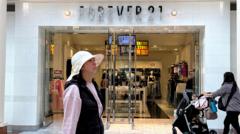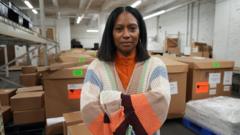As live shopping gains traction in Western markets, can it replicate the success seen in Asia, or is its appeal limited?
**The Rise of Live Shopping: A New Era in Retail?**

**The Rise of Live Shopping: A New Era in Retail?**
Exploring the potential of live shopping and its impact on consumer behavior and retail trends.
Live shopping is reshaping the retail landscape, providing a fresh and engaging way for brands to connect with consumers. Kelsey Krakora, a Cleveland-based entrepreneur, illustrates this shift perfectly. After transitioning from a traditional job in the service industry to selling clothes on platforms like Whatnot and Poshmark, her foray into live commerce has blossomed. "My first live show with Poshmark was on 27th November 2022, and I sold zero things initially... but now I average about 100 items per show, pulling in around $1,000 in sales," she shares.
With shows typically lasting three hours and taking place two to three times weekly, Krakora's events reflect a growing trend in the live shopping arena. Unlike conventional shopping methods, where convenience often dictates purchasing, live shopping offers a unique experience, allowing customers to shop from the comfort of their homes—“Shop in your PJs without a trip to the mall,” Krakora emphasizes.
Originating within the Asia-Pacific region, particularly on platforms like Douyin in China, the live shopping model combines elements of telemarketing with e-commerce, encouraging quick purchasing decisions during live broadcasts. Not surprisingly, this approach has caught fire in the US and Europe, fostering an estimated $32 billion market primarily focused on fashion, beauty, and collectibles.
A 2024 survey revealed that 45% of US consumers have engaged with live shopping events within the past year, indicative of growing acceptance. Industry leaders like Guillaume Faure, CEO of LiveMeUp, noticed a significant increase in interest for live shopping as platforms like Instagram and YouTube introduced features that support real-time engagement and interaction.
Despite its advantages, live shopping's potential remains a topic of debate. Analysts like Sucharita Kodali from Forrester Research question its scalability, suggesting that without the cultural dynamics present in China—like reliance on influential key opinion leaders (KOLs)—the model may struggle to resonate similarly in the US. KOLs like Li Jiaqi, known as the ‘Lipstick King’ in China, have built robust followings that significantly drive their sales results.
Krakora herself gracefully highlights some limitations: "Some products just don't translate well on a live shopping platform. For example, I prefer trying on jeans in person." Retail analyst Bruce Winder warns that not all consumers will be able to manage their spending habits when enticed by engaging presentations. However, for many brands, live shopping has already proven transformative. Major players like Nordstrom, Samsung, and L'Oreal have embraced this model, tailoring their marketing strategies to fit consumer interactions during live events.
Success stories are also emerging overseas, as seen with luxury fragrance brand The House of Amouage, which harnessed the live shopping phenomenon to great effect in China. Their partnership with Nordstrom exemplifies a collective shift towards utilizing real-time feedback to refine product offerings.
Manish Chandra, CEO of Poshmark, aptly summarizes the essence of live shopping: “It’s about creating a community where people can interact and engage with knowledgeable hosts, creating excitement that a typical shopping trip lacks.” As the live shopping trend continues to evolve, its future remains uncertain, but its current impact cannot be overlooked.
With shows typically lasting three hours and taking place two to three times weekly, Krakora's events reflect a growing trend in the live shopping arena. Unlike conventional shopping methods, where convenience often dictates purchasing, live shopping offers a unique experience, allowing customers to shop from the comfort of their homes—“Shop in your PJs without a trip to the mall,” Krakora emphasizes.
Originating within the Asia-Pacific region, particularly on platforms like Douyin in China, the live shopping model combines elements of telemarketing with e-commerce, encouraging quick purchasing decisions during live broadcasts. Not surprisingly, this approach has caught fire in the US and Europe, fostering an estimated $32 billion market primarily focused on fashion, beauty, and collectibles.
A 2024 survey revealed that 45% of US consumers have engaged with live shopping events within the past year, indicative of growing acceptance. Industry leaders like Guillaume Faure, CEO of LiveMeUp, noticed a significant increase in interest for live shopping as platforms like Instagram and YouTube introduced features that support real-time engagement and interaction.
Despite its advantages, live shopping's potential remains a topic of debate. Analysts like Sucharita Kodali from Forrester Research question its scalability, suggesting that without the cultural dynamics present in China—like reliance on influential key opinion leaders (KOLs)—the model may struggle to resonate similarly in the US. KOLs like Li Jiaqi, known as the ‘Lipstick King’ in China, have built robust followings that significantly drive their sales results.
Krakora herself gracefully highlights some limitations: "Some products just don't translate well on a live shopping platform. For example, I prefer trying on jeans in person." Retail analyst Bruce Winder warns that not all consumers will be able to manage their spending habits when enticed by engaging presentations. However, for many brands, live shopping has already proven transformative. Major players like Nordstrom, Samsung, and L'Oreal have embraced this model, tailoring their marketing strategies to fit consumer interactions during live events.
Success stories are also emerging overseas, as seen with luxury fragrance brand The House of Amouage, which harnessed the live shopping phenomenon to great effect in China. Their partnership with Nordstrom exemplifies a collective shift towards utilizing real-time feedback to refine product offerings.
Manish Chandra, CEO of Poshmark, aptly summarizes the essence of live shopping: “It’s about creating a community where people can interact and engage with knowledgeable hosts, creating excitement that a typical shopping trip lacks.” As the live shopping trend continues to evolve, its future remains uncertain, but its current impact cannot be overlooked.














